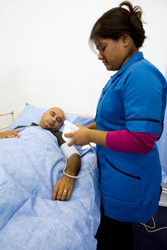UAlbany Study: Future Shortages of Registered Nurses Predicted for New York
Contact(s): Catherine Herman (518) 956-8150
 |
The new Center for Health Workforce Studies report is designed to improve understanding of where RN shortages will be most severe to inform efforts to alleviate shortages. |
ALBANY, N.Y. (November 20, 2008) -- New York is projected to face a shortage of registered nurses (RNs) by the year 2020, according to a new report by UAlbany's Center for Health Workforce Studies. By 2020, New York will require 204,087 RNs to remain consistent with national benchmarks, but the estimated supply will be more than 8,400 -- or four percent -- short.
The Center's report, Toward a Methodology for Substate Projections of Registered Nurse Supply and Demand in New York: Data, Methods, and Preliminary Findings for Counties and County Groups, 2005-2020, examines the nature and scope of RN shortages in New York overall, as well as by counties or groups of counties. There are many drivers of this expected shortage, including growing demand for services, increasing retirements from nursing, and challenges faced by colleges and universities in expanding their RN education program capacity. The report is designed to improve understanding of where RN shortages will be most severe to inform efforts to alleviate shortages.
"Understanding the variation in the scope of RN shortages by region and by county within the state is critical information that stakeholders need to optimally allocate scarce resources to address the problem," said Center Director Jean Moore.
While many sources predict statewide RN shortages through 2020, studies of physicians and other health workers suggest that the health workforce is not evenly distributed throughout the state. Local social, demographic, and economic conditions drive both the supply of and demand for health workers, including RNs.
Key findings by region include:
Capital District Region (Albany, Columbia/Greene, Rensselaer, Saratoga, Schenectady, Warren/Washington counties)
- Schenectady County is projected to face a serious shortage (26 percent) by 2020;
- Saratoga and Rensselaer counties are expected to experience minor shortages (six percent and nine percent, respectively); and
- Albany, Columbia/Greene, and Warren/Washington counties are not anticipated to experience shortages by 2020.
Central New York Region (Chenango/Cortland, Onondaga/Madison/Cayuga, Oswego counties)
- Chenango/Cortland counties and Oswego County are projected to experience serious RN shortages (25 percent and 36 percent, respectively); and
- Onondaga/Madison/Cayuga counties are not expected to experience shortages by 2020.
Finger Lakes Region (Genesee/Orleans, Livingston/Wyoming, Monroe/Wayne and Ontario counties)
- Genesee/Orleans and Livingston/Wayne counties are expected to face serious shortages of RNs (36 percent and 48 percent shortage, respectively);
- Monroe/Wayne counties are projected to experience a five percent shortage; and
- Ontario County is not anticipated to experience a shortage by 2020.
Mohawk Valley Region (Fulton/Montgomery and Herkimer/Oneida counties)
- Fulton/Montgomery counties are projected to experience an RN shortage of 50 percent; and
- Herkimer/Oneida counties are projected to experience a surplus of RNs of 10 percent by 2020.
New York City Region (Bronx, Kings, New York, Queens, Richmond counties)
- Kings, Queens, and Bronx counties are projected to experience 49 percent, 41 percent, and 44 percent RN shortages, respectively;
- New York County is projected to experience a 24 percent shortage; and
- Richmond County is not expected to experience an RN shortage by 2020.
North County Region (Clinton/Essex/Franklin/Hamilton, Jefferson/Lewis, St. Lawrence counties)
- Clinton/Essex/Franklin/Hamilton counties may face a four percent shortage of RNs; and
- Jefferson/Lewis and St. Lawrence counties are not expected to experience RN shortages by 2020.
Southern Tier Region (Broome/Tioga, Chemung/Schuyler, Delaware/Otsego/Schoharie, Seneca/Tompkins, Steuben/Yates counties
- Delaware/Otsego/Schoharie counties are projected to face a severe nursing shortage by 2020 (57 percent); and
- Steuben/Yates, Chemung/Schuyler, Seneca/Tompkins, and Broome/Tioga, counties are all projected to face moderate shortages of RNs by 2020 (23 percent, 21 percent, 21 percent, and 10 percent, respectively).
Western New York Region (Allegany/Cattaraugus, Chautauqua, Erie, Niagara counties)
- All counties are expected to face RN shortages by 2020 (Allegany/Cattaraugus 66 percent, Chautauqua 25 percent, Erie 32 percent, and Niagara 31 percent.)
The Hudson Valley (Dutchess, Orange, Rockland, Sullivan/Ulster, and Westchester/ Putnam counties) and Long Island regions (Nassau and Suffolk counties) are not projected to experience RN shortages by 2020.
The Center for Health Workforce Studies at the University at Albany's School of Public Health conducts studies of the supply, demand, use, and education of the health workforce, and collects and analyzes data to understand workforce dynamics and trends.
![]() For more news, subscribe to UAlbany's RSS headline feeds
For more news, subscribe to UAlbany's RSS headline feeds
Educationally and culturally, the University at Albany-SUNY puts "The World Within Reach" for its 18,000 students. An internationally recognized research university with 58 undergraduate majors and 128 graduate degree programs, UAlbany is a leader among all New York State colleges and universities in such diverse fields as public policy, nanotechnology and criminal justice. With a curriculum enhanced by 300 study-abroad opportunities, UAlbany launches great careers. For more information about this globally ranked University, visit www.albany.edu. For UAlbany's extensive roster of faculty experts, visit www.albany.edu/news/experts.shtml.


